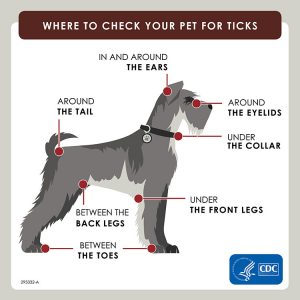
Fleas and ticks are not just a nuisance, they pose serious health risks to pets and people. According to the New York State Department of Health, some of the tick-borne diseases in the state include Rocky Mountain spotted fever, Lyme disease and babesiosis. The challenge for pet owners is how to balance the risk posed by insect bites with the risk of exposing their dogs to the toxins in flea and tick preventatives.
Recently Erin Schoeberl returned home from work to find her dogs acting strange. Annabell, a pit bull mix, looked scared and had head tremors. Bradaigh, a Labrador retriever, had lost the use of his back legs. After speaking with a veterinarian at an emergency center Schoeberl concluded that the dogs might be having a negative reaction to the Seresto flea and tick collars she had put on them just days before.
She immediately removed the collars and washed the dogs’ necks. Annabell quickly returned to normal while Brandaigh was fine by the next day. After researching a possible link between Seresto collars and neurological problems Schoeberl discovered that her dogs weren’t the only ones to exhibit negative reactions.
“I’d been using the collars for three years without a problem,” Schoeberl said. “I’ve stopped using flea and tick preventatives with chemicals. It was a terrifying experience and I just can’t take a chance on having it happen again.”
 Bradaigh and Annabell made a full recovery after a negative reaction to flea and tick preventative collars.
Bradaigh and Annabell made a full recovery after a negative reaction to flea and tick preventative collars.
Do Research Before Choosing a Flea and Tick Preventative
Pet owners definitely need to use caution when using flea and tick preventatives:
In 2010, due to a sharp increase in reported pet poisonings from the use of spot-on flea and tick treatments the Environmental Protection Agency (EPA) increased restrictions on these products and urged consumers to use them with care.
In September 2018, the U.S. Food and Drug Administration (FDA) issued an alert to veterinarians and pet owners for the potential of “neurologic adverse events in dogs and cats when treated with drugs that are in the isoxazoline class.”
The Natural Resource Defense Council (NRDC) reviewed the listed ingredients in more than a hundred flea and tick products. According to the nonprofit, many of the products they analyzed “…contain toxic chemicals that could poison pets and harm people, even when applied as instructed on the box.”
When chemical control is necessary, NRDC experts advise using the organization’s Flea and Tick Product Directory to see which products are the least toxic for your pet.
Parasite Protection is Not a One-Size-Fits-All
According to experts at the American Veterinary Medical Association (AVMA), there are many effective flea and tick preventives on the market. Knowing what kind of product to use, and how to use it, is critical to the health and safety of your pet.
Certain factors affect the type and dose of the product that can be used, including the age, species, breed, lifestyle and health status of your pet, as well as any medications your pet is receiving. Caution is advised when considering flea/tick treatment of very young and very old pets or pets with a chronic illness.
Because one animal may react differently to a product than another, pets need to be monitored carefully for any signs of adverse reactions. Negative reactions can include anxiousness, excessive itching or scratching, skin redness or swelling, vomiting or abnormal behavior.
When Using Natural Products
Pet owners considering the use of natural products to control fleas and ticks need to be aware that even some herbal products are not always safe for pets. For example, products containing the essential oils cinnamon, clove, geranium, tea tree, lavender, bay and eucalyptus can cause severe allergic reactions in pets and people.
At the recommendation of dog owners who use natural flea and tick preventatives, Schoeberl now gives her dogs Bug Off Garlic Chewables. While garlic can be toxic to dogs Schoeberl’s veterinarian said they would have to ingest a huge amount for it to cause any problems.
Following a recent three-hour hike deep in the woods, Schoeberl found a lone tick on one of the dogs, none on the other and seven ticks on herself.
“I was pretty impressed – even when the dogs wore collars I would find ticks on them,” Schoeberl said.
Karen Becker, an integrative wellness veterinarian, typically discourages her clients from using harsh flea and tick preventative chemicals on their pets. A member of both the American Veterinary Medical Association and the American Holistic Veterinary Medical Association, Becker recommends using natural ways to repel fleas and ticks. These include bathing dogs regularly and adding natural predators in the backyard to reduce the flea population.
Holistic veterinarian Natasha Kassell recommends using toxic flea and tick products as minimally as possible and instead focusing on nontoxic or less toxic strategies for managing fleas and ticks.
When Using Preventatives with Chemicals
When it comes to using flea and tick preventatives that contain chemicals, it’s important that pet owners understand what they are buying said Tina Wismer, veterinarian and medical director of the ASPCA Animal Poison Control Helpline. As fleas and ticks are developing resistance to some types of insecticides Wismer said pet owners should consult with their veterinarian as to what works best in a specific location.
Flea and tick products for pets are regulated by the FDA and the EPA. The FDA is responsible for regulating animal drugs while some products to control external parasites come under the jurisdiction of the EPA. Before an animal drug is allowed on the market, the FDA must “approve” it. Before a pesticide can be marketed, the EPA must “register” it. Unfortunately in the U.S. there have been incidences of counterfeit pet pesticides made to look like legitimate products registered by the EPA. The EPA offers information on how to identify counterfeit products on its website.
There are two main categories of products designed for tick prevention. The first is a repellant that discourages ticks from being on your pet. The second doesn’t repel but instead kills the parasite after it has bitten to prevent disease transmission. It typically takes at least 24 hours of attachment for the tick to transmit disease-causing organisms.
Wismer said the number of calls to the Animal Poison Control Helpline regarding negative reactions to flea and tick preventatives is “pretty low.” Most negative reactions, she said, fall into two categories:
Gastrointestinal – Vomiting and/or diarrhea is seen most commonly with oral medications or when dogs lick the topical medication.
Dermal – These reactions occur after topical applications and include redness at the application site, twitching and behavior changes.
Wismer said the most common issue occurs when owners treat cats for fleas with a dog only medication. Another common problem called into the helpline is drooling and vomiting from the taste of the product if the dog or cat licks them while they are still wet. Wismer said owners should always follow the pictures on the label to help reduce the risk of this happening.

The AVMA Offers the Following Tips When Using a Flea and Tick Preventative:
- Discuss the use of preventive products, including over-the-counter products, with your veterinarian to determine the safest and most effective choice for each pet.
- Always talk to your veterinarian before applying any spot-on products, especially if your dog or cat is very young, old, pregnant, nursing, or on any medications.
- Only purchase EPA-registered pesticides or FDA-approved medicines.
- Read the entire label before you use/apply the product.
- Always follow label directions! Apply or give the product as and when directed. Never apply more or less than the recommended dose.
- Cats are not small dogs. Products labeled for use only for dogs should only be used for dogs, and never for cats. Never.
- Make sure that the weight range listed on the label is correct for your pet because weight matters. Giving a smaller dog a dose designed for a larger dog could harm the pet.
- One pet may react differently to a product than another pet. When using these products, monitor your pet for any signs of an adverse reaction, including anxiousness, excessive itching or scratching, skin redness or swelling, vomiting, or any abnormal behavior. If you see any of these signs, contact your veterinarian.
It’s extremely important to report any adverse reactions to flea and tick preventative medications to your veterinarian and to the manufacturer of the product so the reactions can be recorded.
To report problems with EPA-approved pesticides, contact the National Pesticide Information Center (NPIC) at 1-800-858-7378.
To report problems with FDA-approved drugs go to How to Report An Adverse Drug Experience or call 1-888-FDA-VETS. Additional reporting information is available on the FDA’s Report a Problem page.
If your pet does have a negative reaction to a flea and tick preventative, call your veterinarian or local pet emergency center immediately. The ASPCA Animal Poison Control Center can be reached at 888-426-4435.
